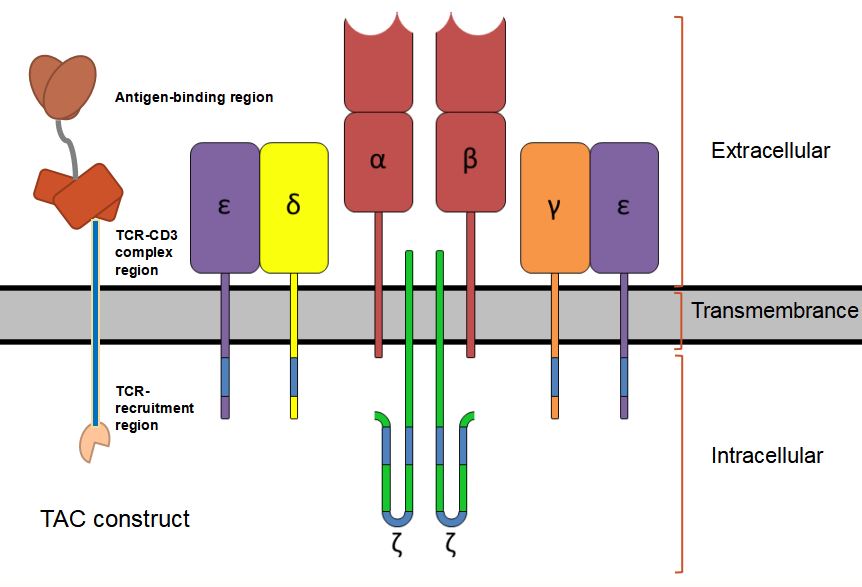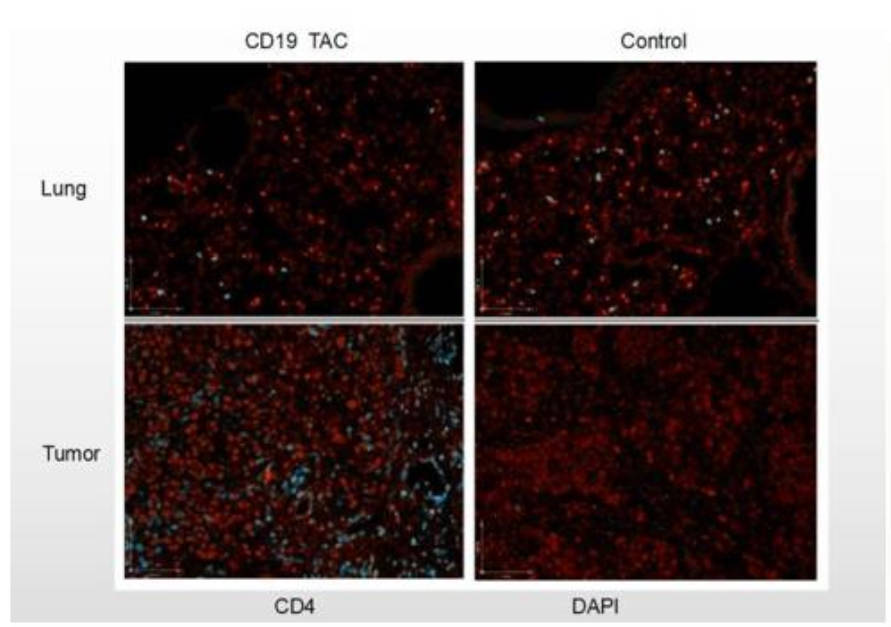

Creative Biolabs provides a comprehensive, high-quality, single-source value chain from discovery to commercialization in T cell antigen connector (TAC) technology. As a research-driven and customer-focus company, we are dedicated to helping our worldwide customers shorten the discovery and development time as well as lower the cost of the T cell antigen connector (TAC) development process.
Currently, we are constantly pioneering the future of T-cell immunotherapy, paving the way for innovations in cell and gene therapy. Our T cell antigen connector (TAC) technology has been considered a next-generation T cell therapy with the potential to co-opt endogenous TCR, induce more effective anti-tumor responses as well as reduced toxicity compared with existing T cell approaches. We are employing cutting-edge TAC design, synthesis, modification, and optimization technology, to target specific cancer-causing antigens in tumor cells, thereby striking the core of the tumor cell.
 Fig.1 The Design and Structure of T Cell Antigen Connector (TAC).
Fig.1 The Design and Structure of T Cell Antigen Connector (TAC).
TAC consists of multiple protein domains: (1) The antigen-binding region, (2) The TCR-CD3 complex region, and (3) The native TCR-recruitment region (including hinge, transmembrane, and cytosolic regions). TAC binds to tumor targets and co-receptor integration and leads to the natural activation of TCR signaling pathways, resulting in T-cell-mediated tumor cell killing.
To be most specific, the antigen-binding region is usually composed of various proteins, such as CD19, HER2, EGFR, or PD-1/PD-L1 antigens, that can bind to the TCR complex. Up to now, our platform supports many forms of antigen-binding proteins, including but not limited to, single chain variable fragment (scFv) antibodies, VHH antibodies (or nanobodies), single-domain antibodies, peptide aptamers, as well as diabodies. Moreover, the CD3 TCR complex region is designed by using different proteins that bind to CD3 proteins, like CD3γ protein, CD3δ protein, or a CD3ε protein. For instance, a variety of CD3 antibody clones, including SK7, UCHT-1, YTH 12.5, OKT3, m291, F6A, or L2K, have been generated widely for naturally occurring TCR-CD3 complex development. Also, CD4 and CD8, co-receptors for the T-cell receptor, are commonly been used for establishing TCR-recruitment regions and specific co-receptor regions.
 Fig.2 TAC-T Therapy Service Platform Workflow.
Fig.2 TAC-T Therapy Service Platform Workflow.
To meet the challenging requirements, Creative Biolabs has built a team of experienced scientists with facilities and processes designed specifically to offer a full range of custom TAC development services from design to validation. We assist our clients in exploiting a wide array of novel technologies to provide the best strategy and protocols customized to suit any TAC-engineered T-cell project. Currently, we have developed a growing list of protocols for TAC products, including TAC-T lentiviruses, TAC-T cells, and well-mature validation and characterization assays for evaluating target-specific TAC-T activation and cancer cell killing.
Creative Biolabs is proud to contribute to the promising field of novel T-cell immunotherapy by providing a panel of translational assays for TAC-T cellular therapy testing of on-target efficacy and safety profile. Normally, the efficacy and cytotoxicity of TAC-T cell therapies should be further assessed to offer meaningful data (see example below) to your lead therapy.
 Fig.3 CD19 TAC-Engineered T cell Distribution and In Vivo Efficacy Analysis in Both Solid and Liquid Tumor Models.
Fig.3 CD19 TAC-Engineered T cell Distribution and In Vivo Efficacy Analysis in Both Solid and Liquid Tumor Models.
In our labs, CD19-directed TAC-T cell therapies have been designed for triggering native TCR recruitment by using a CD19 scFv derived from clone FMC63, a CD3 scFv derived from clone UCHT1, as well as a CD4 co-receptor domain. A series of functional analysis assays, for instance, flow cytometry-based analysis assays, have been broadly used for detecting the expression of checkpoint receptors and memory T cell subsets in TAC-T cells, evaluating the efficacy and toxicities of TAC-T cells in various tumor models.
If you have any special needs in TAC adoptive immunotherapy services or be interested in learning more about Creative Biolabs' TAC services, please feel free to contact us for more details.
For Research Use Only